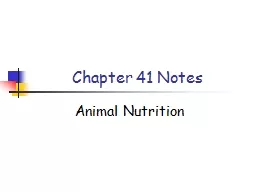

Nutritional Requirements The flow of energy into and out of an animal can be viewed as a budget most of the energy taken in is used to produce ATP to power resting metabolism and temperature regulation ID: 777781
Download The PPT/PDF document "Chapter 41 Notes Animal Nutrition" is the property of its rightful owner. Permission is granted to download and print the materials on this web site for personal, non-commercial use only, and to display it on your personal computer provided you do not modify the materials and that you retain all copyright notices contained in the materials. By downloading content from our website, you accept the terms of this agreement.
Slide1
Chapter 41 Notes
Animal Nutrition
Slide2Nutritional Requirements
The flow of energy into and out of an animal can be viewed as a “budget”
- most of the energy taken in is used to produce ATP to power resting metabolism and temperature regulation
- excess ATP can be used for biosynthesis
Slide3Nutritional Requirements
In humans, the liver and muscle cells store energy in the form of glycogen.
If glycogen stores are full, the excess is usually stored as fat.
When fewer calories are taken in than used, fuel is taken out of storage deposits and oxidized.
Slide4Nutritional Requirements
Slide5Nutritional Requirements
Feedback mechanisms regulate fat storage and use
- an increase in adipose tissue increases leptin levels in the blood
- high levels of leptin cue the brain to depress appetite and to increase muscular activity and body-heat production
Slide6Nutritional Requirements
In addition to providing fuel for ATP, a diet must also supply the raw materials needed for biosynthesis.
- organic precursors (carbon skeletons)
-
essential amino acids
-
essential fatty acids
-
vitamins
and
minerals
Slide7Nutritional Requirements
Slide8Food Types and Feeding Mechanisms
Even though animals are classified as
herbivores
,
carnivores
, or
omnivores
, they are
opportunistic feeders
in that they eat foods outside of their main dietary categories
Slide9Food Types and Feeding Mechanisms
There are four main groups that animals can be separated into based on the way they feed
Suspension-feeders
: animals that sift food particles from water
Substrate-feeders
: animals that live on their food source, eating their way through food
Slide10Food Types and Feeding Mechanisms
Fluid-feeders
: animals the survive by sucking nutrient-rich fluids from a living host
Bulk-feeders
: animals that eat relatively large pieces of food
Slide11Overview of Food Processing
The four main stages of food processing are ingestion, digestion, absorption, and elimination
Ingestion
: the act of eating
Digestion
: the process of breaking food down into molecules small enough for the body to absorb
-
enzymatic hydrolysis
Slide12Overview of Food Processing
Absorption
: the animal’s cells take up small molecules such as amino acids and simple sugars
Elimination
: undigested material passes out of the digestive compartment
Slide13Overview of Food Processing
Digestion occurs in specialized compartments to reduce the risk of self-digestion
Intracellular digestion
: use of food vacuoles where hydrolytic enzymes break down food without digesting the cell’s cytoplasm
Slide14Overview of Food Processing
Slide15Overview of Food Processing
Extracellular digestion
: the breakdown of food outside cells
Many animals with simple body plans have
gastrovascular cavities
- these function in both the digestion and distribution of nutrients throughout the body
Slide16Overview of Food Processing
Slide17Overview of Food Processing
Most animals have digestive tubes extending between two openings- complete
digestive tracts
or
alimentary canals
- the advantage is that animals can ingest additional food before earlier meals are completely digested
Slide18Overview of Food Processing
Slide19The Mammalian Digestive System
The oral cavity, pharynx, and esophagus initiate food processing
- the presence of food in the oral cavity triggers the release of
saliva
.
-saliva contains
amylase
, the enzyme that hydrolyzes starch
Slide20The Mammalian Digestive System
The stomach stores food and performs preliminary digestion
- the stomach secretes
gastric juices
and mixes them with food by a churning motion
- also present in the gastric juices is
pepsin
, an enzyme that begins the hydrolysis of proteins
Slide21The Mammalian Digestive System
Slide22The Mammalian Digestive System
The small intestine is the major organ of digestion and absorption
- the first 25 cm of the small intestine is called the
duodenum
. Here chyme from the stomach is mixed with juices from the pancreas, liver, and gall bladder
Slide23The Mammalian Digestive System
Slide24The Mammalian Digestive System
- the pancreas produces hydrolytic enzymes and an alkaline solution that acts as a buffer to neutralize the low pH of the chyme from the stomach
- the liver produces
bile
. Bile does not contain enzymes, but acts as detergents that aid in the digestion and absorption of fats
Slide25The Mammalian Digestive System
Carbohydrate digestion
:
- begins with salivary amylase in the oral cavity
- pancreatic amylase hydrolyzes starch, glycogen, and other polysaccharides into disaccharides
Slide26The Mammalian Digestive System
Protein digestion
:
- enzymes in the duodenum break apart proteins into amino acids
-
trypsin
and
chymotrypsin
break the peptide bonds
Slide27The Mammalian Digestive System
Fat digestion
:
- hydrolysis of fat is a special problem because fat molecules are insoluble in water
- bile salts work through
emulsification
so that
lipase
can break down fat molecules
Slide28The Mammalian Digestive System
Most absorption occurs in the small intestine
- s.i. has a large surface area due to the folding of the lining into
villi
- each villus has many microscopic appendages called
microvilli
which increase the rate of absorption
Slide29The Mammalian Digestive System
- in the core of each villus is a net of capillaries and a small vessel of the lymphatic system called the
lacteal
- nutrients are absorbed across the intestinal epithelium and then across the epithelium of the capillaries or lacteals
- nutrients then flow into the bloodstream
Slide30The Mammalian Digestive System